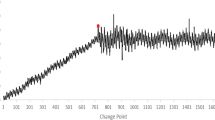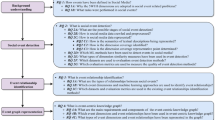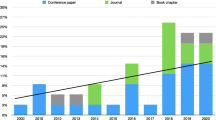Abstract
Anomalous daily activities are the activities that do not fit into normal daily behavior of social media users. Discovering anomalous daily activities is important for protecting social media users from harmful content and providing correct information about populated accounts, products, or hashtags. However, discovering anomalous daily activities is challenging due to hardness of detection of bot applications, complexity of anomalous activities, and the big data nature of social media datasets. In this study, a novel method that discovers anomalous daily activities with respect to spatio-temporal information of social media datasets is proposed. For this purpose, an interest measure, named as social velocity, is proposed to discover anomalous daily activities that is based on spatial distance and temporal difference of successive posts. Two novel algorithms are proposed that use proposed method and interest measure and experimentally evaluated on a real Twitter dataset. The experimental results show that proposed algorithms are successful for discovering anomalous activities of social media users with respect to spatio-temporal information.












Similar content being viewed by others
References
Chu Z, Gianvecchio S, Wang H, Jajodia S (2012) Detecting automation of twitter accounts: Are you a human, bot, or cyborg?. IEEE Transactions on Dependable and Secure Computing 9(6):811–824. https://doi.org/10.1109/TDSC.2012.75
Yu R, Qiu H, Wen Z, Lin C, Liu Y (2016) A survey on social media anomaly detection. ACM SIGKDD Explorations Newsletter 18(1):1–14. https://doi.org/10.1145/2980765.2980767
Kaur R, Singh S (2016) A survey of data mining and social network analysis based anomaly detection techniques. Egyptian Informatics Journal 17(2):199–216. https://doi.org/10.1016/j.eij.2015.11.004
Savage D, Zhang X, Yu X, Chou P, Wang Q (2014) Anomaly detection in online social networks. Soc Networks 39:62–70. https://doi.org/10.1016/j.socnet.2014.05.002
Bindu PV, Thilagam PS (2016) Mining social networks for anomalies: Methods and challenges. J Netw Comput Appl 68:213–229. https://doi.org/10.1016/j.jnca.2016.02.021
Gao Y, Wang S, Padmanabhan A, Yin J, Cao G (2018) Mapping spatiotemporal patterns of events using social media: a case study of influenza trends. Int J Geogr Inf Sci 32(3):425–449. https://doi.org/10.1080/13658816.2017.1406943
Chae J, Thom D, Bosch H, Jang Y, Maciejewski R, Ebert D S, Ertl T (2012) Spatiotemporal social media analytics for abnormal event detection and examination using seasonal-trend decomposition. In: 2012 IEEE conference on visual analytics science and technology (VAST), pp 143–152
Chalapathy R, Chawla S (2019) Deep learning for anomaly detection: A survey. CoRR abs/1901.03407, arXiv:1901.03407
Wang Z, Joo V, Tong C, Xin X, Chin H C (2014) Anomaly detection through enhanced sentiment analysis on social media data. In: 2014 IEEE 6th international conference on cloud computing technology and science, pp 917–922
Tonon A, Cudré-Mauroux P, Blarer A, Lenders V, Motik B (2017) Armatweet: Detecting events by semantic tweet analysis. In: Blomqvist E, Maynard D, Gangemi A, Hoekstra R, Hitzler P, Hartig O (eds) The semantic web, pp 138–153. Springer International Publishing, Cham
Tam NT, Weidlich M, Zheng B, Yin H, Hung NQV, Stantic B (2019) From anomaly detection to rumour detection using data streams of social platforms. Proceedings of the VLDB Endowment 12 (9):1016–1029. https://doi.org/10.14778/3329772.3329778
Akoglu L, McGlohon M, Faloutsos C (2010) oddball: Spotting anomalies in weighted graphs. In: Zaki M J, Yu J X, Ravindran B, Pudi V (eds) Advances in knowledge discovery and data mining, pp 410–421. Springer Berlin Heidelberg
Hassanzadeh R, Nayak R (2013) A rule-based hybrid method for anomaly detection in online-social-network graphs. In: 2013 IEEE 25th international conference on tools with artificial intelligence, pp 351–357
Garcia-Rubio C, Díaz Redondo RP, Campo C, Fernandez Vilas A (2018) Using entropy of social media location data for the detection of crowd dynamics anomalies. Electronics, 7(12). https://doi.org/10.3390/electronics7120380
Fernandez Vilas A, Díaz Redondo RP, Ben Khalifa M (2019) Analysis of crowds’ movement using twitter. Comput Intell 35(2):448–472. https://doi.org/10.1111/coin.12205
Ferrari L, Rosi A, Mamei M, Zambonelli F (2011) Extracting urban patterns from location-based social networks. In: Proceedings of the 3rd ACM SIGSPATIAL international workshop on location-based social networks, pp 9–16
Dokuz AS, Celik M (2017) Discovering socially important locations of social media users. Expert Syst Appl 86:113–124. https://doi.org/10.1016/j.eswa.2017.05.068
Celik M, Dokuz AS (2017) Discovering socio-spatio-temporal important locations of social media users. J Comp Sci 22:85–98. https://doi.org/10.1016/j.jocs.2017.09.005
Han J, Lee H (2015) Adaptive landmark recommendations for travel planning: Personalizing and clustering landmarks using geo-tagged social media. Pervasive and Mobile Computing 18:4–17. https://doi.org/10.1016/j.pmcj.2014.08.002
Khatibi A, Belém F, da Silva APC, Almeida JM, Gonçalves MA (2020) Fine-grained tourism prediction: Impact of social and environmental features. Information Processing & Management 57 (2):102057. https://doi.org/10.1016/j.ipm.2019.102057
Sakaki T, Okazaki M, Matsuo Y (2010) Earthquake shakes twitter users: Real-time event detection by social sensors. In: Proceedings of the 19th international conference on World Wide Web, pp 851–860
Xu Z, Liu Y, Yen N, Mei L, Luo X, Wei X, Hu C (2017) Crowdsourcing based description of urban emergency events using social media big data. IEEE Transactions on Cloud Computing, pp 1–11. https://doi.org/10.1109/TCC.2016.2517638
Pohl D, Bouchachia A, Hellwagner H (2016) Online indexing and clustering of social media data for emergency management. Neurocomputing 172:168–179. https://doi.org/10.1016/j.neucom.2015.01.084
Arcaini P, Bordogna G, Ienco D, Sterlacchini S (2016) User-driven geo-temporal density-based exploration of periodic and not periodic events reported in social networks. Inf Sci 340-341:122–143. https://doi.org/10.1016/j.ins.2016.01.014
Hasan M, Orgun MA, Schwitter R (2019) Real-time event detection from the twitter data stream using the twitternews+ framework. Information Processing & Management 56(3):1146–1165. https://doi.org/10.1016/j.ipm.2018.03.001
Zhang S, Mao X, Choo K-K R, Peng T, Wang G (2020) A trajectory privacy-preserving scheme based on a dual-k mechanism for continuous location-based services. Inf Sci 527:406–419. https://doi.org/10.1016/j.ins.2019.05.054
Cai G, Lee K, Lee I (2018) Itinerary recommender system with semantic trajectory pattern mining from geo-tagged photos. Expert Syst Appl 94:32–40. https://doi.org/10.1016/j.eswa.2017.10.049
Hu F, Li Z, Yang C, Jiang Y (2019) A graph-based approach to detecting tourist movement patterns using social media data. Cartogr Geogr Inf Sci 46(4):368–382. https://doi.org/10.1080/15230406.2018.1496036
Yao H, Xiong M, Zeng D, Gong J (2018) Mining multiple spatial–temporal paths from social media data. Futur Gener Comput Syst 87:782–791. https://doi.org/10.1016/j.future.2017.08.003
Yu D, Chen N, Jiang F, Fu B, Qin A (2017) Constrained nmf-based semi-supervised learning for social media spammer detection. Knowl-Based Syst 125:64–73. https://doi.org/10.1016/j.knosys.2017.03.025
Yu R, He X, Liu Y (2015) Glad: Group anomaly detection in social media analysis. ACM Transactions on Knowledge Discovery from Data 10(2):18:1–18:22. https://doi.org/10.1145/2811268
Giridhar P, Amin MT, Abdelzaher T, Wang D, Kaplan L, George J, Ganti R (2016) Clarisense+: An enhanced traffic anomaly explanation service using social network feeds. Pervasive and Mobile Computing 33:140–155. https://doi.org/10.1016/j.pmcj.2016.03.005
Chua A, Marcheggiani E, Servillo L, Vande Moere A (2015) Flowsampler: Visual analysis of urban flows in geolocated social media data. In: Aiello L M, McFarland D (eds) Social informatics, pp 5–17. Springer International Publishing, Cham
Santos BP, Rettore PHL, Ramos HS, Vieira LFM, Loureiro AAF (2018) Enriching traffic information with a spatiotemporal model based on social media. In: 2018 IEEE Symposium on computers and communications (ISCC), pp 00464–00469
Huang C, Wu X, Wang D (2016) Crowdsourcing-based urban anomaly prediction system for smart cities. In: Proceedings of the 25th ACM international on conference on information and knowledge management, pp 1969–1972
Sakkari M, D. Algarni A, Zaied M (2019) Urban crowd detection using som, dbscan and lbsn data entropy: A twitter experiment in new york and madrid. Electronics, 8(6). https://doi.org/10.3390/electronics8060692
Xu Z, Cui G, Zhong M, Wang X (2019) Anomalous urban mobility pattern detection based on gps trajectories and poi data. ISPRS International Journal of Geo-Information 8(7):308:1–308:20. https://doi.org/10.3390/ijgi8070308
Kim J, Bae J, Hastak M (2018) Emergency information diffusion on online social media during storm cindy in u.s. Int J Inf Manag 40:153–165. https://doi.org/10.1016/j.ijinfomgt.2018.02.003
Jayarajah K, Subbaraju V, Weerakoon D, Misra A, Tam LT, Athaide N (2017) Discovering anomalous events from urban informatics data. In: Pham T, Kolodny MA (eds) Ground/Air Multisensor Interoperability, Integration, and Networking for Persistent ISR VIII, pp 70–83
Wang S, Zhang X, Cao J, He L, Stenneth L, Yu PS, Li Z, Huang Z (2017) Computing urban traffic congestions by incorporating sparse gps probe data and social media data. ACM Trans Inf Syst 35(4):40:1–40:30. https://doi.org/10.1145/3057281
Shin S, Choi M, Choi J, Langevin S, Bethune C, Horne P, Kronenfeld N, Kannan R, Drake B, Park H, Choo J (2017) Stexnmf: Spatio-temporally exclusive topic discovery for anomalous event detection. In: 2017 IEEE International conference on data mining (ICDM), pp 435–444
Chae J, Cui Y, Jang Y, Wang G, Malik A, Ebert DS (2015) Trajectory-based Visual Analytics for Anomalous Human Movement Analysis using Social Media. In: Bertini E, Roberts JC (eds) EuroVis workshop on visual analytics (EuroVA), pp 43–47. The Eurographics Association
Pan B, Zheng Y, Wilkie D, Shahabi C (2013) Crowd sensing of traffic anomalies based on human mobility and social media. In: Proceedings of the 21st ACM SIGSPATIAL international conference on advances in geographic information systems, pp 344–353
Gabrielli L, Rinzivillo S, Ronzano F, Villatoro D (2014) From tweets to semantic trajectories: Mining anomalous urban mobility patterns. In: Nin J, Villatoro D (eds) Citizen in Sensor Networks, pp 26–35. Springer International Publishing, Cham
Viswanath B, Bashir MA, Crovella M, Guha S, Gummadi KP, Krishnamurthy B, Mislove A (2014) Towards detecting anomalous user behavior in online social networks. In: 23rd USENIX Security Symposium (USENIX Security 14), pp 223–238. USENIX Association, San Diego, CA
Cao N, Shi C, Lin S, Lu J, Lin Y, Lin C (2016) Targetvue: Visual analysis of anomalous user behaviors in online communication systems. IEEE Trans Vis Comput Graph 22(1):280–289. https://doi.org/10.1109/TVCG.2015.2467196
Harikant N, Suma V (2017) Risk analysis in facebook based on user anomalous behaviors. In: 2017 International conference on intelligent computing and control systems (ICICCS), pp 967–971
Dokuz AS (2019) Anomalous activity detection from daily social media user mobility data. Nigde Omer Halisdemir Universitesi Muhendislik Bilimleri Dergisi 8:638–651. https://doi.org/10.28948/ngumuh.535232
Twitter (2019) Twitter developers web site. https://dev.twitter.com/
Yamamoto Y (2019) Twitter4j java library. http://twitter4j.org/en/index.html
Author information
Authors and Affiliations
Corresponding author
Additional information
Publisher’s note
Springer Nature remains neutral with regard to jurisdictional claims in published maps and institutional affiliations.
Rights and permissions
About this article
Cite this article
Dokuz, A.S. Social velocity based spatio-temporal anomalous daily activity discovery of social media users. Appl Intell 52, 2745–2762 (2022). https://doi.org/10.1007/s10489-021-02535-8
Accepted:
Published:
Issue Date:
DOI: https://doi.org/10.1007/s10489-021-02535-8




